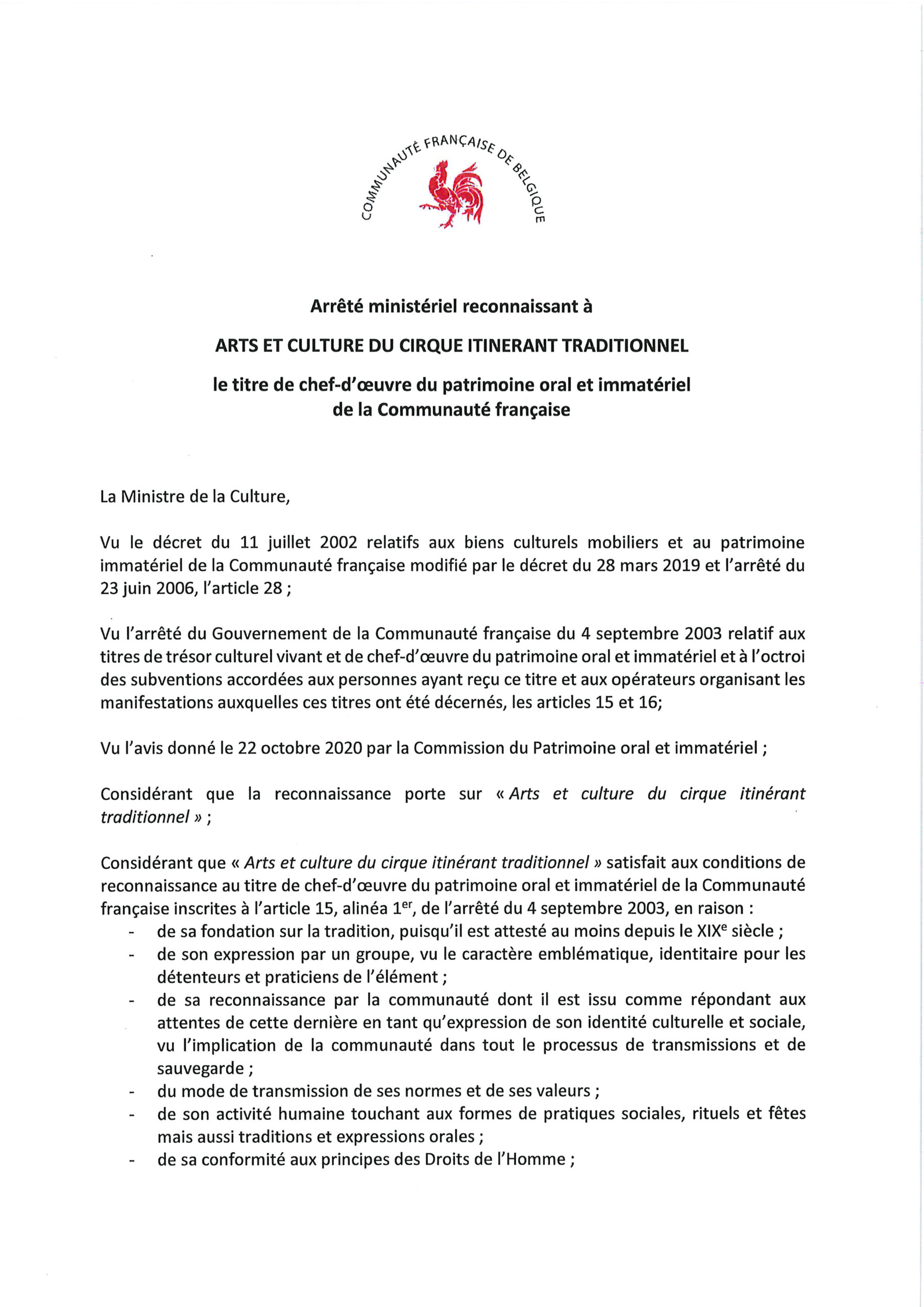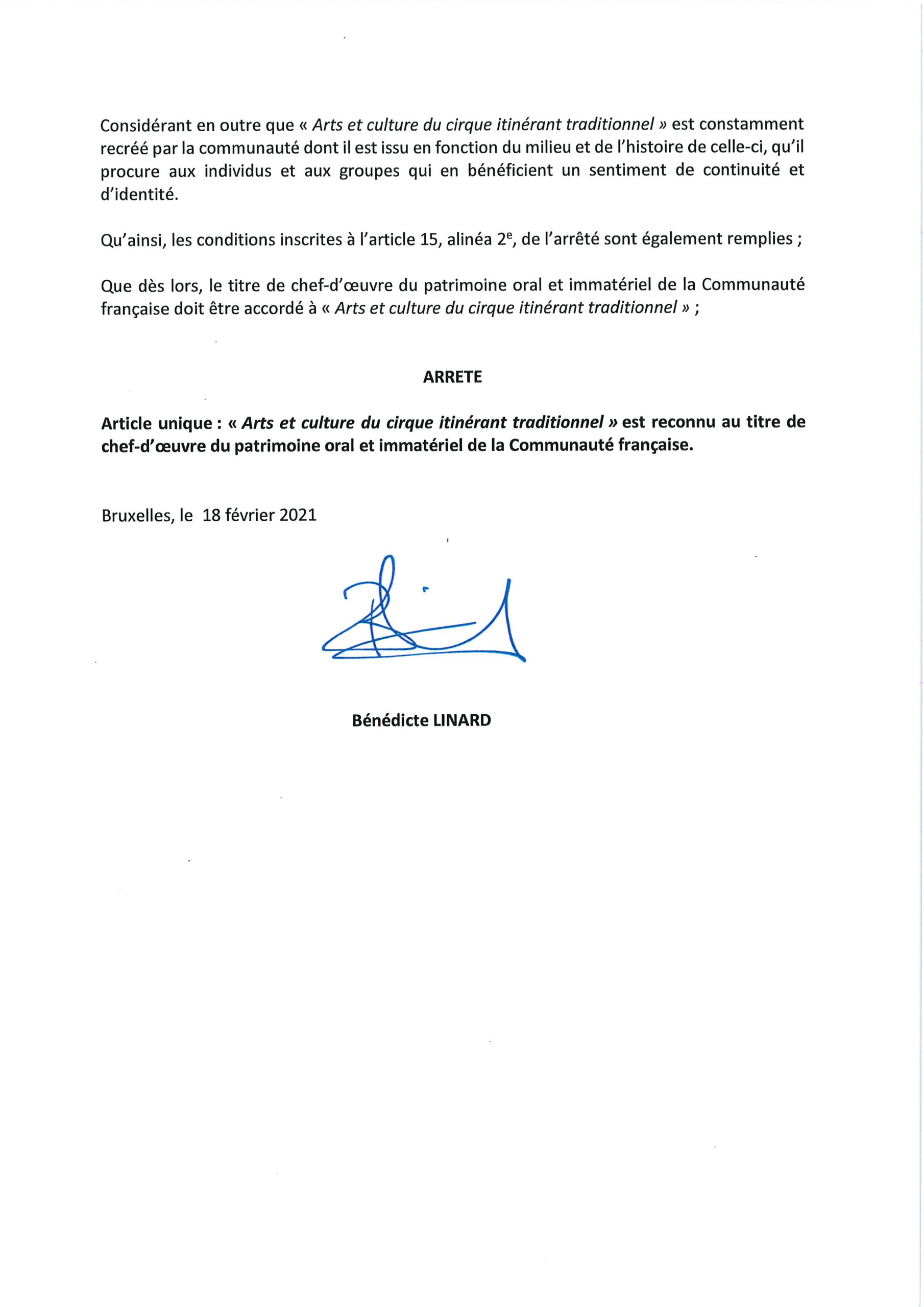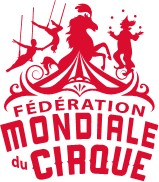Congratulations!
The traditional travelling circus arts has been recognized as part of the Intangible Cultural Heritage (ICH) of Wallonie.
The Fédération Mondiale du Cirque congratulates the Circus Community of Wallonie on that great achievement.
Wallonie became the 4th in Europe to recognize circus arts as part of ICH.
As a result of several years of hard work on this project initiated and led by Mr Alain Gombert, and thanks to the wonderful collaboration between the stakeholders and the cultural government of Wallonie today we all can be proud of this new recognition of our art-form.”
“In 2017, I learned that the City of Brussels was going to devote the year 2018 to the circus. When I went to the website dedicated to the festivities, I realised that the celebrations only concerned the contemporary circus, as if the traditional circus had never existed. Faced with this flagrant injustice, I contacted the authorities and obtained an appointment at the Heritage Department. Armed with a photo album of my family, some of whose documents proved the tradition of the circus in Belgium since the end of the 19th century, I went to the offices of the Ministry of Culture of the Wallonia-Brussels Federation (French-speaking part of Belgium). While leafing through the album, the person in charge immediately recognised the cultural value of this heritage and encouraged me to write the dossier.
This dossier required a lot of work and I was able to count on the support of Belgian circus directors (Bouglione, European Circus Festival), but also on friends of the circus (Jan Ingelbrecht, Laurent Lavend’Homme). Mrs Zsuzsanna Mata also supported me in this process.
Nevertheless, it took several corrections spread over three years to submit the file in September 2020 and this was the beginning of a long wait for approval. Finally, in February 2021, I received a letter from the head of the Ministry who helped me so much (Marie Depraetere), informing me that the file was accepted and that the traditional circus was recognised as a heritage masterpiece in the Wallonia-Brussels Federation.
After publishing the good news on Facebook, I received a shower of congratulations. I knew that this step would be beneficial for traditional circuses not only in Belgium, but in the whole of Europe.
Alain Gombert Chabri ”
French version:
“En 2017, j’ai appris que la Ville de Bruxelles allait consacrer l’année 2018 au cirque. En me rendant sur le site dédié aux festivités, je me suis aperçu que les célébrations concernaient uniquement le cirque contemporain, comme si le cirque traditionnel n’avait jamais existé. Face à cette injustice flagrante, j’ai pris contact avec les autorités et j’ai obtenu un rendez-vous au service Patrimoine. Muni d’un album de photos de ma famille dont certains documents prouvaient la tradition du cirque en Belgique depuis la fin du XIXème siècle, je me suis rendu dans les bureaux du Ministère de la Culture de la Fédération Wallonie-Bruxelles (partie francophone de la Belgique). En feuilletant l’album, la responsable a tout de suite reconnu la valeur culturelle de ce patrimoine et m’a encouragé à rédiger le dossier.
Ce dossier a demandé beaucoup de travail et j’ai pu compter sur le soutien des directeurs de cirques belges (Bouglione, European Circus Festival), mais aussi sur des amis du cirque (Jan Ingelbrecht, Laurent Lavend’Homme). Mme Zsuzsanna Mata m’a également soutenu dans cette démarche.
Il aura tout de même fallu plusieurs corrections étalées sur trois ans pour déposer le dossier en septembre 2020 et ce fut le début d’une longue attente en vue d’une approbation. Finalement, en février 2021, j’ai reçu un courrier de la responsable du Ministère qui m’a tant aidé (Marie Depraetere), m’informant que le dossier est accepté et que le cirque traditionnel est reconnu comme chef-d’œuvre du patrimoine en Fédération Wallonie-Bruxelles.
Après avoir publié la bonne nouvelle sur Facebook, j’ai reçu une pluie de félicitations. Je sus que cette démarche allait être bénéfique pour les cirques traditionnels non seulement en Belgique, mais dans l’Europe entière.
Alain Gombert Chabri»



